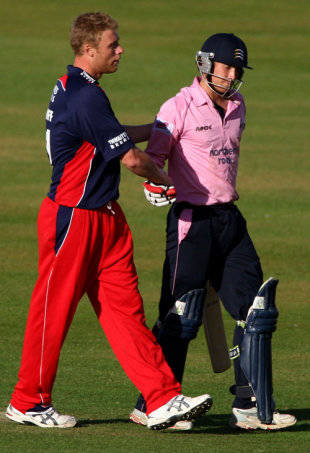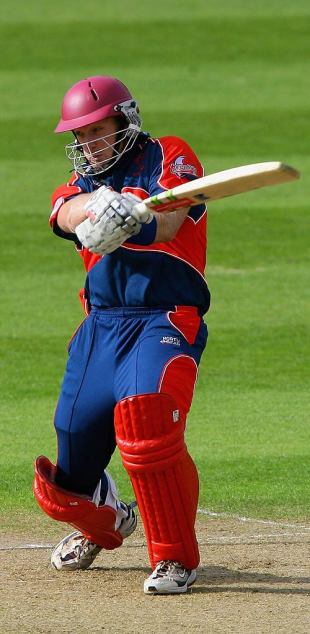Born for Twenty20
Following David Warner's incredible debut for Australia, a look at XI players whose careers have been inspired by Twenty20

| ||
There is always something special about a young sportsman making a mockery of the supposed importance of experience. Malan had shown an abundance of flair, but it wasn't until Middlesex's televised quarter-final last year that he transferred his obvious potential into match-winning elegance. A breathless 103 from just 51 balls sank Lancashire and lit up the Twenty20 Cup in extraordinary style. Yet for all the silky strokeplay, it was his mental approach to the innings that most stood out; Middlesex were in a hole at 21 for 4 before he altered the game completely, against an attack containing a revitalised Andrew Flintoff, the competitiveness of Dominic Cork, and an ageless Glen Chapple. Malan's subdued celebrations reeked of steely confidence; a degree of youthful arrogance hinting that there is plenty more to come.
It was his first innings of the tournament, and thrilling at that. Rohit came to the crease with India struggling on 33 for 3 against South Africa, in the inaugural ICC World Twenty20, and quickly asserted himself. After putting on 85 with MS Dhoni, Rohit soon had South Africa on the back foot - literally, in some cases, as there were a number of fielding gaffes. He finished the innings with a magnificent six off Johan van der Wath, the sort of justified extravagance from Indian batsmen that has now become their calling card. Sharma's influence led to India reaching 153 for 5, a total South Africa never got near to chasing, and his promise continued with two vital fifties in the CB Series against Australia.
What Napier lacks in elegance he more than makes up for in power. Before 2008, he had only ever flirted with consistency and sashayed coyly with success, but he achieved both in the Twenty20 Cup after an innings of bravado and audacity that kickstarted his career. Rewriting the record books, Napier carved his way to an unbeaten 152 from just 58 balls of unabashed mayhem, murdering Sussex's bowlers (only Robin Martin-Jenkins escaped) to crack the highest score in England's Twenty20 Cup. It included no fewer than 16 sixes - albeit at Chelmsford, where the boundaries are puny - and his last 52 came from a mere 14 deliveries. He followed that innings up with a guttural 40 and 61 in the Friends Provident Trophy, picking up vital wickets along the way, but continued to be ignored by England's one-day selectors.
For someone who delivers the ball off the wrong foot, not to mention his initial lack of Twenty20 success, Tanvir was altogether a surprise package in 2008, yet quickly became the outstanding fast bowler in the Indian Premier League. In 11 matches for Rajasthan Royals he scorched 22 wickets at an impossibly miserly 12.09, grabbing the best Twenty20 figures of all with a devastating spell of 6 for 14 against the Chennai Super Kings. He is a fascinating bowler to watch: a left-armed Mike Procter, given his awkward wrong-footed delivery style, yet with the control of swing that Wasim Akram possessed and mastered. His IPL form prompted a surge in confidence in his one-day ability, too, with impressive all-round displays for Pakistan (albeit against Zimbabwe).
For all the hoohah over Sir Allen Stanford's involvement in English cricket, his domestic Twenty20 tournament in the Caribbean has unearthed potential stars who might otherwise have been left at the mercy of West Indies' inter-island politicking. One such player is Fletcher, a tall, strapping right-hander who was part of Stanford's Superstars team that beat England last November. Before the tournament, the team were Superstars in name only, but Fletcher's uninhibited 90 against Middlesex gave evidence that Twenty20 could be the ideal vehicle for discovering new talent in a cricketing region desperately fighting against a decline. Crucially, Fletcher mostly relied on orthodox shots and he played remarkably straight, not with the cavalier madness often associated with Twenty20 batting, launching sixes into the night sky. "If it's there, I hit it," he said with pleasing nonchalance.
White arrived at Taunton in 2006 as a 22-year-old legspinner with a handful of ODIs under his belt for Australia, but with plenty of hope rested on his shoulders. Yet it was with the bat that he had the greatest impact, and in one-day cricket in particular. In the Twenty20 Cup he cracked a brutal 141, his hundred coming from a scarcely credible 55 balls (a Twenty20 record at the time), and the innings appeared to cement in people's minds, if not his own, that he was no longer a bowling allrounder but a batsman who occasionally spun the ball. He finished the summer with 1190 first-class runs at 59.50.

| ||
Twenty20 has provided has-beens and nearly-beens with an enjoyable stroll in the park, as well as reinvigorating other careers, such as Jeremy Snape's and Adam Hollioake's. But it has also brought some left-field selections such as Baker, who until Stanford and Twenty20 arrived was a virtual unknown. He was picked for the Stanford Super Series in October and November, though he played no part, before making his one-day and Test debuts in November and December. Would he have been noticed were it not for Stanford and his crew casting their nets as wide as Monserrat, and would Baker have become the island's first international cricketer?
Another of Shane Warne's Rajasthan Royals who responded to the intense spotlight of the IPL with a regal display. An apparently laconic character, he is transformed in the shortest format of the game, striking the ball with consistent power and timing, and is flexible enough to bat wherever he is told. In last year's IPL he finished with 435 runs at 31.07. Not the highest aggregate or average, but his strike-rate of over 179 was comfortably the best of those who made more than 200 runs. His four fifties epitomised the format itself: aggressive and fearless power-hitting, no better exemplified than in his 21-ball fifty against Deccan Chargers - the fastest in the tournament. Shane Warne, his captain and coach, calls him The Statement Maker, and Pathan's sublime form consequently earned him a call-up to the national one-day side.
Never has the phrase "friendly giant" been more fitting. Henderson, a great hulking figure with a barnet from the 1970s, is an unlikely hero: the most underestimated of medium-paced nagging seamers. In the days before Twenty20 he rarely threatened to break into the strong South African national team in spite of an impressive average. Yet when the new young man's game came in, he proved that a consistent line and canny changes of pace - allied with the guts of a lion to bowl at the death - were every bit as important as the whippersnappers' energy and verve. Consequently he is now the leading wicket-taker in the world with 74 at 21.29. Little more than a rabbit in first-class cricket, he was a player transformed in Twenty20s, able to hit out of the ground with ease and was even promoted to No. 3 by Middlesex in the Twenty20 Finals Day last summer.
Another IPL star, another classical batsman to have made the transition to Twenty20 look like a cakewalk. Marsh, son of Geoff, was one of Punjab's success stories of 2008: a reliable and simple technique, allied with a calm demeanour, culminated in Marsh becoming one of the most consistent run-scorers in the tournament. When Twenty20 was first introduced, there was an initial hurry to employ sloggers and bashers, the theory being that more orthodox batsmen, like Marsh, would get stuck in the mud. Marsh is one of many who has proved that for all Twenty20's culture of innovation, convention only needs to be tweaked slightly to produce success. With 616 runs at 68.44 in the IPL - far and away the top run-scorer - it wasn't long before he was an irresistible selection for Australia.
Pollard emerged like an angry, impetuous caterpillar who'd been cocooned in the chrysalis for too long. Muscularly built, he stands tall and relaxed at the crease, and cracked 83 for Trinidad in the 2006 Stanford 20/20 final, a whole five months before his first-class debut. It was a thudding assault from a young man intent on domination, but this was no fluke: when he finally played his first four-day game, he made 126. He hasn't yet pushed on internationally - 47 runs in eight ODIs suggests the jump from Stanford's domestic competition is bigger than he thought.
Will Luke is a staff writer at Cricinfo